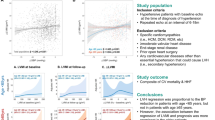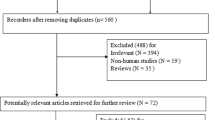Abstract
Left ventricular hypertrophy (LVH) is an independent cardiovascular risk factor; however, the key strategy necessary for LVH regression in hypertensive patients is not clear. A meta-analysis was conducted to study the effect of blood pressure reduction on LVH regression. We explored the relationship between different degrees of systolic blood pressure (SBP)/diastolic blood pressure (DBP) reduction and LVH regression. A total of 17 randomized controlled trials comprising 2196 hypertensive patients (mean age, 56.3 years; 64.1% were men) were identified. Different degrees of SBP and DBP reductions were significantly associated with LVH regression: SBP reduction ⩾20 mm Hg (SBPM20) (weighted mean difference (WMD): 14.35 g m−2; 95% confidence interval (CI): 10.44, 18.26; P<0.0001); SBP reduction <20 mm Hg (SBPL20 group) (WMD: 14.82 g m−2; 95% CI: 9.83, 19.82; P<0.0001); DBP reduction ⩾10 mm Hg (DBPM10 group) (WMD: 15.17 g m−2; 95% CI: 11.86, 18.48; P<0.0001); and DBP reduction <10 mm Hg (DBPL10 group) (WMD: 11.76 g m−2; 95% CI: 3.75, 19.76; P=0.004). Significant regression of LVH was found in the DBPM10 group compared with the SBPM20, SBPL20 and DBPL10 groups (P<0.0001). The most significant decrease in LVH was seen in patients with a mean age over 60 years in the DBPM10 group. Moreover, the renin–angiotensin system inhibitor was found to be the most effective antihypertensive drug for LVH regression. This meta-analysis result indicates that proper DBP reduction plays an important role in the regression of echocardiographic LVH in hypertensive patients.
This is a preview of subscription content, access via your institution
Access options
Subscribe to this journal
Receive 12 digital issues and online access to articles
$119.00 per year
only $9.92 per issue
Buy this article
- Purchase on Springer Link
- Instant access to full article PDF
Prices may be subject to local taxes which are calculated during checkout







Similar content being viewed by others
References
Levy D, Anderson KM, Savage DD, Kannel WB, Christiansen JC, Castelli WP . Echocardiographically detected left ventricular hypertrophy: prevalence and risk factors. The Framingham Heart Study. Ann Intern Med 1988; 108: 7–13.
Levy D, Garrison RJ, Savage DD, Kannel WB, Castelli WP . Prognostic implications of echocardiographically determined left ventricular mass in the Framingham Heart Study. N Engl J Med 1990; 322: 1561–1566.
Schillaci G, Verdecchia P, Porcellati C, Cuccurullo O, Cosco C, Perticone F . Continuous relation between left ventricular mass and cardiovascular risk in essential hypertension. Hypertension 2000; 35: 580–586.
Vakili BA, Okin PM, Devereux RB . Prognostic implications of left ventricular hypertrophy. Am Heart J 2001; 141: 334–341.
Devereux RB, Palmieri V, Liu JE, Wachtell K, Bella JN, Boman K et al. Progressive hypertrophy regression with sustained pressure reduction in hypertension: the Losartan Intervention for Endpoint Reduction study. J Hypertens 2002; 20: 1445–1450.
Verdecchia P, Schillaci G, Guerrieri M, Gatteschi C, Benemio G, Boldrini F et al. Circadian blood pressure changes and left ventricular hypertrophy in essential hypertension. Circulation 1990; 81: 528–536.
Verdecchia P, Angeli F, Gattobigio R, Guerrieri M, Benemio G, Porcellati C . Does the reduction in systolic blood pressure alone explain the regression of left ventricular hypertrophy? J Hum Hypertens 2004; 18 (Suppl 2): S23–S528.
Okin PM, Hille DA, Kjeldsen SE, Dahlof B, Devereux RB . Impact of lower achieved blood pressure on outcomes in hypertensive patients. J Hypertens 2012; 30: 802–810.
Chobanian AV, Bakris GL, Black HR, Cushman WC, Green LA, Izzo JL et al. The Seventh Report of the Joint National Committee on Prevention, Detection, Evaluation, and Treatment of High Blood Pressure: the JNC 7 report. JAMA 2003; 289: 2560–2572.
Jiang N, Wang B, Chen A, Dong F, Yu B . Operative versus nonoperative treatment for acute Achilles tendon rupture: a meta-analysis based on current evidence. Int Orthop 2012; 36: 765–773.
Williams B, Lindholm LH, Sever P . Systolic pressure is all that matters. Lancet 2008; 371: 2219–2221.
Sever P . Is systolic blood pressure all that matters? Yes. BMJ 2009; 339: b2665.
Bangalore S, Messerli FH, Wun CC, Zuckerman AL, DeMicco D, Kostis JB et al. J-curve revisited: an analysis of blood pressure and cardiovascular events in the Treating to New Targets (TNT) Trial. Eur Heart J 2010; 31: 2897–2908.
O'Brien E . Is systolic blood pressure all that matters? No. BMJ 2009; 339: b2669.
Batkai S, Thum T . MicroRNAs in hypertension: mechanisms and therapeutic targets. Curr Hypertens Rep 2012; 14: 79–87.
Burns J, Ball SG, Worthy G, Struthers AD, Mary DA, Greenwood JP . Hypertensive left ventricular hypertrophy: a mechanistic approach to optimizing regression assessed by cardiovascular magnetic resonance. J Hypertens 2012; 30: 2039–2046.
Franklin SS, Wt Gustin, Wong ND, Larson MG, Weber MA, Kannel WB et al. Hemodynamic patterns of age-related changes in blood pressure. The Framingham Heart Study. Circulation 1997; 96: 308–315.
Franklin SS, Khan SA, Wong ND, Larson MG, Levy D . Is pulse pressure useful in predicting risk for coronary heart Disease? The Framingham Heart Study. Circulation 1999; 100: 354–360.
Orias M, Tabares AH, Peixoto AJ . Hypothesis: it is time to reconsider phenotypes in hypertension. J Clin Hypertens (Greenwich) 2010; 12: 350–356.
Whitworth JA . 2003 World Health Organization (WHO)/International Society of Hypertension (ISH) statement on management of hypertension. J Hypertens 2003; 21: 1983–1992.
Mancia G, De Backer G, Dominiczak A, Cifkova R, Fagard R, Germano G et al. 2007 Guidelines for the Management of Arterial Hypertension: The Task Force for the Management of Arterial Hypertension of the European Society of Hypertension (ESH) and of the European Society of Cardiology (ESC). J Hypertens 2007; 25: 1105–1187.
Cushman WC, Evans GW, Byington RP, Goff DC, Grimm RH, Cutler JA et al. Effects of intensive blood-pressure control in type 2 diabetes mellitus. N Engl J Med 2010; 362: 1575–1585.
Okin PM . Regression of electrocardiographic left ventricular hypertrophy by losartan versus atenolol: The Losartan Intervention For Endpoint Reduction in Hypertension (LIFE) Study. Circulation 2003; 108: 684–690.
Machnig T, Henneke KH, Engels G, Pongratz G, Schmalzl M, Gellert J et al. Nitrendipine vs. captopril in essential hypertension: effects on circadian blood pressure and left ventricular hypertrophy. Cardiology 1994; 85: 101–110.
Fogari R, Zoppi A, Mugellini A, Tettamanti F, Lusardi P, Corradi L . Effects of lisinopril vs hydralazine on left ventricular hypertrophy and ambulatory blood pressure monitoring in essential hypertension. Eur Heart J 1995; 16: 1120–1125.
Tedesco MA, Ratti G, Aquino D, Limongelli G, di Salvo G, Mennella S et al. Effects of losartan on hypertension and left ventricular mass: a long-term study. J Hum Hypertens 1998; 12: 505–510.
Hoglund C, Cifkova R, Mimran A, Tenczer J, Watt A, Wilkins MR et al. A comparison of the effects of mibefradil and atenolol on regression of left ventricular hypertrophy in hypertensive patients. Cardiology 1998; 89: 263–270.
Agabiti-Rosei E, Zulli R, Muiesan ML, Salvetti M, Rizzoni D, Corbellini C et al. Reduction of cardiovascular structural changes by nifedipine GITS in essential hypertensive patients. Blood Press 1998; 7: 160–169.
Thurmann PA, Kenedi P, Schmidt A, Harder S, Rietbrock N . Influence of the angiotensin II antagonist valsartan on left ventricular hypertrophy in patients with essential hypertension. Circulation 1998; 98: 2037–2042.
Gosse P, Sheridan DJ, Zannad F, Dubourg O, Gueret P, Karpov Y et al. Regression of left ventricular hypertrophy in hypertensive patients treated with indapamide SR 1.5 mg versus enalapril 20 mg: the LIVE study. J Hypertens 2000; 18: 1465–1475.
Devereux RB, Palmieri V, Sharpe N, De Quattro V, Bella JN, de Simone G et al. Effects of once-daily angiotensin-converting enzyme inhibition and calcium channel blockade-based antihypertensive treatment regimens on left ventricular hypertrophy and diastolic filling in hypertension: the prospective randomized enalapril study evaluating regression of ventricular enlargement (preserve) trial. Circulation 2001; 104: 1248–1254.
Cuspidi C, Muiesan ML, Valagussa L, Salvetti M, Di Biagio C, Agabiti-Rosei E et al. Comparative effects of candesartan and enalapril on left ventricular hypertrophy in patients with essential hypertension: the candesartan assessment in the treatment of cardiac hypertrophy (CATCH) study. J Hypertens 2002; 20: 2293–2300.
Gaudio C, Ferri FM, Giovannini M, Pannarale G, Puddu PE, Vittore A et al. Comparative effects of irbesartan versus amlodipine on left ventricular mass index in hypertensive patients with left ventricular hypertrophy. J Cardiovasc Pharmacol 2003; 42: 622–628.
Galzerano D, Tammaro P, Cerciello A, Breglio R, Mallardo M, Lama D et al. Freehand three-dimensional echocardiographic evaluation of the effect of telmisartan compared with hydrochlorothiazide on left ventricular mass in hypertensive patients with mild-to-moderate hypertension: a multicentre study. J Hum Hypertens 2004; 18: 53–59.
de Luca N, Mallion JM, O'Rourke MF, O’Brien E, Rahn KH, Trimarco B et al. Regression of left ventricular mass in hypertensive patients treated with perindopril/indapamide as a first-line combination: the REASON echocardiography study. Am J Hypertens 2004; 17: 660–667.
Yasunari K, Maeda K, Watanabe T, Nakamura M, Yoshikawa J, Asada A . Comparative effects of valsartan versus amlodipine on left ventricular mass and reactive oxygen species formation by monocytes in hypertensive patients with left ventricular hypertrophy. J Am Coll Cardiol 2004; 43: 2116–2123.
Agabiti-Rosei E, Trimarco B, Muiesan ML, Reid J, Salvetti A, Tang R et al. Cardiac structural and functional changes during long-term antihypertensive treatment with lacidipine and atenolol in the European Lacidipine Study on Atherosclerosis (ELSA). J Hypertens 2005; 23: 1091–1098.
Rosendorff C, Dubiel R, Xu J, Chavanu KJ . Comparison of olmesartan medoxomil versus amlodipine besylate on regression of ventricular and vascular hypertrophy. Am J Cardiol 2009; 104: 359–365.
Yamamoto K, Ozaki H, Takayasu K, Akehi N, Fukui S, Sakai A et al. The effect of losartan and amlodipine on left ventricular diastolic function and atherosclerosis in Japanese patients with mild-to-moderate hypertension (J-ELAN) study. Hypertens Res 2011; 34: 325–330.
Fogari R, Mugellini A, Destro M, Corradi L, Lazzari P, Zoppi A et al. Losartan and amlodipine on myocardial structure and function: a prospective, randomized, clinical trial. Diabet Med 2012; 29: 24–31.
Acknowledgements
This work was supported in part by NSFC [81170647, 91029742, 30973207 and 11101439], Fok Ying-Tong Education Foundation for Young Teachers in the Higher Education Institutions of China [132030], Yat-sen Scholarship for Young Scientists and the Science & technology star of Zhujiang (Guangzhou) to Hui Huang.
Author information
Authors and Affiliations
Corresponding author
Ethics declarations
Competing interests
The authors declare no conflict of interest.
Rights and permissions
About this article
Cite this article
Zhang, K., Chen, J., Liu, Y. et al. Diastolic blood pressure reduction contributes more to the regression of left ventricular hypertrophy: a meta-analysis of randomized controlled trials. J Hum Hypertens 27, 698–706 (2013). https://doi.org/10.1038/jhh.2013.20
Received:
Revised:
Accepted:
Published:
Issue Date:
DOI: https://doi.org/10.1038/jhh.2013.20
Keywords
This article is cited by
-
Association of ambulatory blood pressure with coronary microvascular and cardiac dysfunction in asymptomatic type 2 diabetes
Cardiovascular Diabetology (2022)
-
Physical Exercise Combined with Antihypertensive Drug Therapy on Left Ventricular Hypertrophy: Systematic Review and Meta-Analysis
High Blood Pressure & Cardiovascular Prevention (2020)
-
A Contemporary Approach to Hypertensive Cardiomyopathy: Reversing Left Ventricular Hypertrophy
Current Hypertension Reports (2020)
-
Association of histamine with hypertension-induced cardiac remodeling and reduction of hypertrophy with the histamine-2-receptor antagonist famotidine compared with the beta-blocker metoprolol
Hypertension Research (2018)
-
Cross-sectional association of volume, blood pressures, and aortic stiffness with left ventricular mass in incident hemodialysis patients: the Predictors of Arrhythmic and Cardiovascular Risk in End-Stage Renal Disease (PACE) study
BMC Nephrology (2015)



